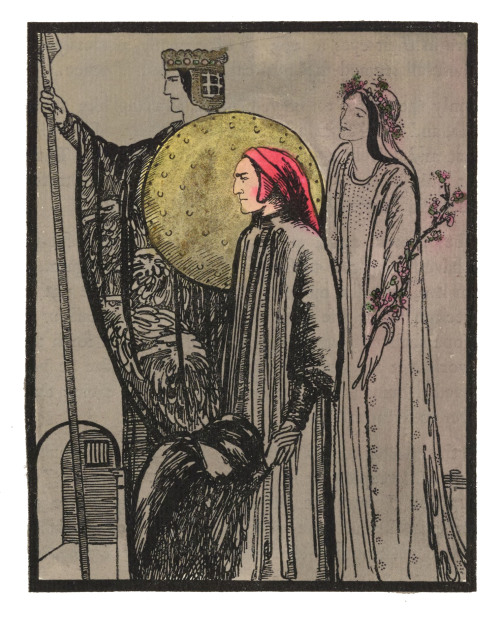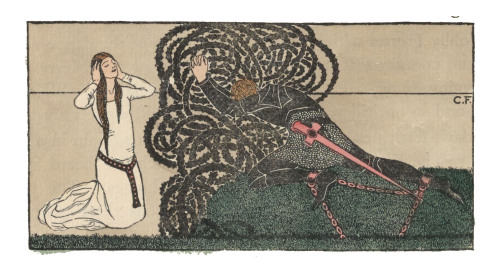Hey, so, great news, someone finally uploaded every issue of Pamela Colman Smith’s Green Sheaf
Hey, so, great news, someone finally uploaded every issue of Pamela Colman Smith’s Green Sheaf magazine to archive.org. It’s all available for free in high resolution, and I did some tasteful chopping and stitching to put together a single PDF with all of the content from every issue. The Green Sheaf has never been reprinted, so, I went ahead and made some physical copies as well (it’s kind of expensive, sorry, but it’s full color and it looks nice). The illustrations in this post are by Pamela Colman Smith, Cecil Frank, and AE, in that order. Didn’t know AE was an illustrator? Me neither! Every page of this book is good. You can read my full introduction to the book after the break. Pamela Colman Smith (known to her friends as “Pixie”) secured her place in the history of Western esoterica in 1909, after she was commissioned to illustrate a new tarot deck by the author and mystic A.E. Waite. The illustrations were instantly iconic upon release, and their popularity was greatly bolstered by Waite’s failure to copyright the work in the United States. The cards, henceforth in the public domain, were widely circulated in new decks, in books, on merchandise, album covers, and so on and so forth - unlikely fuel for the American consumerist behemoth. Over a century and change, the Waite-Rider Tarot’s visual style has been firmly cemented in popular culture as a stock aesthetic of the esoteric and occult. In The Green Sheaf (1903 - 1904), we can see some of the artistic foundations of those cards being developed. Ancient archetypes processed by modern symbolists; forms and figures plucked from folklore and myth, rendered in bold lines and flat colors. As editor, Pixie commissioned work from her various social circles in London; she drew on previous connections from A Broad Sheet (another arts magazine, co-edited with Jack Butler Yeats), as well as the Lyceum Theatre Group, the Hermetic Order of the Golden Dawn, literary celebrities from the Irish & Celtic Revivals, and gay rights activists from the secret Order of the Chaeronea. As she developed her magazine, Pixie regularly gathered her friends for weekly salons at her studio in Chelsea; Arthur Ransom, a contemporary English writer, described one of these nights in a chapter of his book of essays, Bohemia in London (1907). “She welcomed us with the oddest shriek,” Ransome recalls of meeting Pixie for the first time, in 1901. “It was the oddest, most uncanny little shriek, half laugh, half exclamation. It made me very shy. It was obviously an affection, and yet seemed just the right manner of welcome from the strange little creature, ‘god daughter of a witch and sister to a fairy’ who uttered it.” In a ‘mad room out of a fairy tale,’ with its walls covered in drawings and paintings from around the world, and curated with such fanciful artifacts and baubles as to ‘have the effect of a well designed curiosity shop,’ Ransome was treated to an evening of poetry, storytelling, and song. Pixie and her friends performed for one another amid the smoke of cigarettes and thick incense; the cocktail of the evening was the ‘opal hush,’ an amethystine blend of lemonade and red claret. A visitors’ book was kept, signed by the attendees with caricatures and rhymes, the pages ‘used as a tournament field’ of jest between friends. After this introduction to the studio, Ransome made a point to return each week to Pixie’s parties. “Always we were merry. The evening was never wasted. There I heard poetry read as if the ghost of some old minstrel had descended on the reader, and shown how the words should be chanted aloud.” The spirit of Pixie’s salon was distilled, like an alchemist’s solution, into The Green Sheaf. It ran for 13 hand-colored issues. Included in its pages were not just contemporary voices, but fragments from the Gothic-Romance-era masters such as William Blake, Anna Laetitia Barbauld, and John Keats. The magazine made themes of dreaming, spirituality, and a longing for a world to which we can never return. In contrast to the popularity of her Tarot designs, Pixie’s Sheaf fell immediately into obscurity; prior to this volume, it has never been collected or republished. With that grievous error corrected, it is my pleasure to present to you, thunderously and without mercy, the complete Green Sheaf. May it be enshrined in crystal, evermore.Aladdin Collar,Founder, the American Eldritch Society for the Preservation of Hearsay and Rumor -- source link
#tarot#occult#esoterica#aesthetic periodicals#literature#fantasy#dream#wonder#pixie#poetry#vintage illustration#1900s



